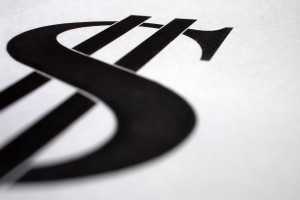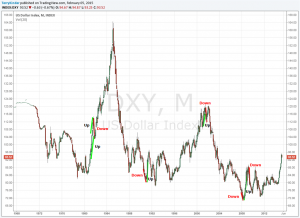Can we have a weak economy and a strong dollar?
 Bullion.Directory precious metals analysis 6 February, 2015
Bullion.Directory precious metals analysis 6 February, 2015
By Terry Kinder
Investor, Technical Analyst
Could the conventional wisdom that a weak economy translates into a weak dollar be wrong?
I think a lot of news stories, analysis and commentary should start with “Once upon a time…” because much of what we read is just fairy tales for grown ups. One of these tales is the idea that when the economy is weak the dollar must be weak.

A weak economy does not automatically mean a weaker dollar. Image: morgueFile
We humans too often suffer from short-term thinking. At the same time, we’re prone to draw long-term parallels. Sometimes those parallels are pretty perceptive and other times they aren’t. We see patterns where they are and also where they aren’t. It’s easy to go back twenty, forty, even sixty years and find a similar looking pattern or event to what we are living through today. But, in the grand scheme of things, mere decades isn’t a sufficient time scale to make an accurate analysis. Martin Armstrong, in his work, has gathered literally thousands of years worth of data and fed it into his computer in order to arrive at an analysis that is well worth listening to.
However, you don’t need to sift through thousands of years of data to prove that the simple binary relationship between a weak economy and a weak dollar doesn’t hold water. You merely need to roll the clock back a handful of decades to prove that the relationship between the economy and the strength of the dollar isn’t so simple.
If we do a couple of things we can quickly see that the dollar has strengthened at least a couple of times during times where the economy was in recession.
1. Take a look at a list of recessions;
2. Glance at a chart of the U.S. Dollar Index (DXY) price.
Looking at the chart above there were five recessions:
1. January to July 1980: The dollar went up;
2. July 1981 to November 1982: The dollar moved up, then down. Overall the dollar ended lower;
3. July 1990 to March 1991: The dollar moved down, then up. Overall the dollar ended higher;
4. March 2001 to November 2001: The dollar moved up, then down. Overall the dollar ended higher;
5. December 2007 to June 2009: The dollar moved down, then up, then down again. Overall the dollar ended just a bit higher.
So, obviously looking at the economy and the dollar price as a simple binary relationship isn’t going to work.
Another correlation often cited is between interest rates and the U.S. Dollar. Tom McClellan of McClellan Oscillator fame cites the relationship in the Dollar is Wandering Off Track.
McClellan writes:
But the belief that a relationship exists between interest rates and currencies is not completely wrong. The key to unlocking that relationship lies in seeing the lag time involved. This week’s chart helps to explain that relationship better. The plot of the effective Fed Funds rate is shifted forward by 3 years to reveal that the Dollar Index tends to follow in the same footsteps 3 years later. So yes, interest rates matter, but not for 3 years.
It’s an interesting point brought up by McClellan that there is a lag between the Fed Funds rate and the dollar. McClellan is good at picking these types of correlations out. For instance, he is also known for pointing out a correlation between oil prices and the stock market on a lag as well.
However, correlation is not causation, so we should be cautious in depending on such relationships to hold up for long periods of time. I wonder if these correlations, measured over only a few decades, will stand the test of time.
One other brief observation on the Fed Funds Rate and dollar correlation pointed out by McClellan – if you look at the chart in his article, the correlation from about 1995 on doesn’t look as strong. There might be some reasons for this, but I’m not going to speculate on what they might be.
In the end, it can be dangerous to make assumptions. A weak economy does not necessarily mean a weak dollar. Correlation is not causation. The world is complex – too complex to assume binary relationships are fixed for any great length of time.
Bullion.Directory or anyone involved with Bullion.Directory will not accept any liability for loss or damage as a result of reliance on the information including data, quotes, charts and buy/sell signals contained within this website. Please be fully informed regarding the risks and costs associated with trading in precious metals. Bullion.Directory advises you to always consult with a qualified and registered specialist advisor before investing in precious metals.













 Material provided on the Bullion.Directory website is strictly for informational purposes only. The content is developed from sources believed to be providing accurate information. No information on this website is intended as investment, tax or legal advice and must not be relied upon as such. Please consult legal or tax professionals for specific information regarding your individual situation. Precious metals carry risk and investors requiring advice should always consult a properly qualified advisor. Bullion.Directory, it's staff or affiliates do not accept any liability for loss, damages, or loss of profit resulting from readers investment decisions.
Material provided on the Bullion.Directory website is strictly for informational purposes only. The content is developed from sources believed to be providing accurate information. No information on this website is intended as investment, tax or legal advice and must not be relied upon as such. Please consult legal or tax professionals for specific information regarding your individual situation. Precious metals carry risk and investors requiring advice should always consult a properly qualified advisor. Bullion.Directory, it's staff or affiliates do not accept any liability for loss, damages, or loss of profit resulting from readers investment decisions.

Leave a Reply